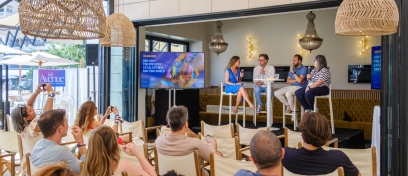For brands
Focus on Gen Z: Raising the Bar for Retail
Gen Z shoppers are experimenters and explorers
Most are familiar with the general shopping behaviour of Gen Z consumers; they have an omnichannel approach to shopping, they are indiscriminate about using all available purchasing channels and sources of information depending on what suits them best at the time. Although many retailers already understand how these shoppers differ from older generations (including Millennials) brands need to focus harder on the challenges and opportunities this presents when trying to reach this generation of shopper.Most importantly, brands must not assume that Gen Z’s shopping behaviours and preferences will necessarily change as they mature to match those of the older generations. It is reasonable to expect that these consumers will carry through their presently high expectations of retailers, and continue changing the face of modern retail.
Naturally social
Unlike for other generation groups, including Millennials, social media plays a more natural role in the lives of Gen Z. This generation embraces social media in all areas of their lives and it has a greater impact on its shopping behaviours than other consumer groups. Gen Z is the most willing group to buy products and services via social media and they are more impulsive buyers than Millennials:- 60% more say they have bought something spontaenously because they felt like it or because they saw something on social media
- 70% can not wait/are willing to try buying on social media in the future
Visuals are King
Homing in on their social media usage, Gen Z focuses on pictures and videos on platforms such as YouTube, Instagram and Snapchat for inspiration before deciding what to buy.- Almost twice as many Gen Z shoppers as Millennials check out YouTube before making a purchase
- 66% Gen Zs use Instagram to help decide
- Gen Zs are twice as likely to use Snapchat compared to Millennials
- 37% of Gen Zs have increased their use of social media for purchase decision-making in the last year
Bricks and mortar stores are still the favourite
Some may be surprised that although 24% of Gen Zs prefer online shopping, most of these shoppers still want to visit physical stores to make their purchases. Importantly, their store visits are multi-media, multi-channel events;- 60% Gen Z shoppers prefer purchasing in physical stores, rising to 77% in the USA
- 46% say they check in store to get more information before purchasing online
- They utilise all available sources during the purchase process:
- Face-to-face engagement with sales people
- Use mobiles to compare prices
- Ask advice of friends and family in person or via social media, text, mobile
- Check social media channels for opinions and reviews
- Use in-store, self-service digital information sources
Expecting an instant delivery
Once Gen Zs find something they like, they want to buy it straight away. Retailers may have successfully caught the attention of Gen Z on social media or elsewhere however, if they fail to accommodate for a simple shopping experience from the platform, many of these young shoppers will walk away from the purchase altogether.Gen Z shoppers want their shopping to be easier and faster and are willing to try new services that facilitate these desires.
- 73% use or would try voice-activated ordering, such as Apple’s Siri, Google’s Assistant or Amazon’s Alexa
- 71% are interested in automatic replenishment programs
- 73% are interested in curated subscription-type services, particularly for fashion, consumer electronics, health and beauty products
Speed is of the essence to Gen Z, even more so than it is to Millennials. They are more likely to cancel an online order if the delivery timing is not clear and fewer are willing to wait for long free deliveries. They want speedy deliveries and are willing to pay extra to get it.
- 58% would pay more than US $5 for one-hour deliveries
Shoppers without brand loyalty
The Gen Z cohort is going through a period of experimentation and development in their lives so their lax brand loyalties reflect this. As the retail industry evolves with more and more new products appearing on the market, it is possible that this generation will never develop the type of shopper loyalty we see among older generations.Firstly, this means that retailers and brands must focus on how to attract these young shoppers. Secondly, these are savvy shoppers, so brands must also offer encompassing quality experiences because Gen Z seeks more than just a purchase. This attitude is more prevalent for some categories than others.
- Clothing & Fashion: only 16% shop in a single store compared to 26% of Millennials
- Health & Beauty: 19% shop in a single store vs 34% Millennials
- Groceries: loyalty is slightly higher here among Gen Z with 38% vs Millennials 55%
Culture and development create variations
There is no doubt that as a whole, Gen Z shoppers rely heavily on technology to inform their purchase decisions. However, habits still differ among cultures and regions.- In China, Gen Z shops online and via social media significantly more than the global average
- In Europe habits vary; Swedish Gen Z is almost twice as willing to buy via social media, while German Gen Z is less than half as willing.
- American Gen Z has a strong preference for in-store shopping
Going beyond the expected media choice
To catch Gen Z’s attention, retailers must offer a cross-platform, digitally integrated, interactive and personalised shopping experience end-to-end. However, to maintain the attention of this fickle audience, they must also focus on raising and maintaining awareness and top-of-mind status of their offering. Relying solely on digital and social media messaging would be a mistake because alone, they do not deliver the critical mass required.A recent global study by Kantar revealed some interesting and for some, counterintuitive findings regarding media preferences among Gen Z, Gen Y and Gen X. Data shows that despite growing up in the digital age, Gen Z holds OOH as the favourite medium for advertising.
- 55% are positive about receiving ads on Out-of-Home
- Only a 1/3 enjoy online ads and even fewer like receiving ads on their mobile
In fact, Gen Z puts more effort into avoiding online ads than Gen Y and Gen X:
- 70% skip ads vs 66% Gen Y and 62% Gen X
- 52% use ad blockers vs 50% Gen Y and 41% Gen X
OOH marries perfectly with Gen Z’s preference toward visual information. And it comes as no surprise as it would be hard to think of a more innately visual advertising medium. Combining the high frequency and the regularity of OOH exposure as well as data-integrated digital opportunities, the very best campaigns can build cross-media strategies that deliver immersive storytelling, experiences and relevant contextual content that Gen Z values so much.
Although it may not have been the obvious choice in today’s digital world, it OOH appears to be the channel to reach and leave an impression among the mass Gen Z audience.




